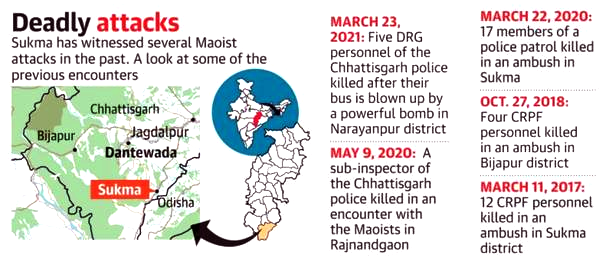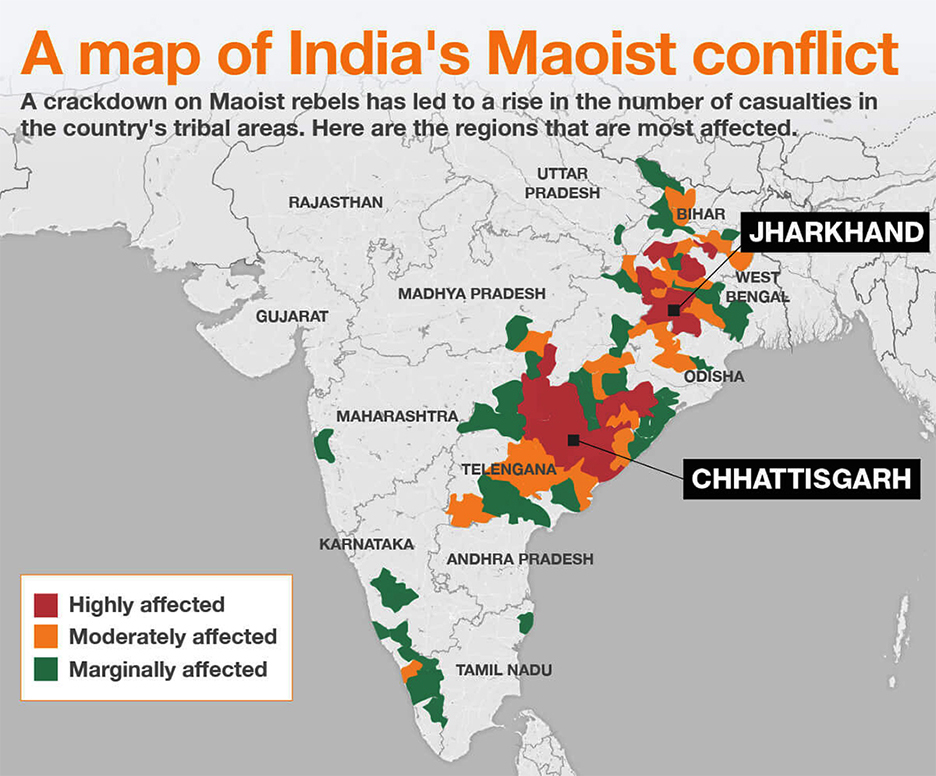Internal Security
Maoist Attack in Sukma
- 05 Apr 2021
- 6 min read
Why in News
A team of security forces was attacked by a People’s Liberation Guerilla Army (PLGA) unit in the Tarrem area near the Sukma-Bijapur district border, Chhattisgarh. Several security personnel were killed and many were injured.
- PLGA was founded in 2000. It has been declared as a terrorist organisation and banned under the Unlawful Activities (Prevention) Act-1967 (UAPA).
Key Points
- About the Sukma District:
- Located in the southern tip of the state of Chhattisgarh, the district was carved out of Dantewada in the year 2012.
- It is covered with the semi-tropical forest and is a mainland of tribal community Gond.
- One major river that flows through the district is Sabari (a tributary of Godavari river).
- Over a few decades, this region has become a fostering ground for Left Wing Extremism (LWE) activities.
- Uneven terrains and the tricky geographic locations made this region a safer hideout for the LWE activists.
- Left Wing Extremism in India:
- Left-wing extremists, popularly known as Maoists worldwide and as Naxalites in India.
- The term Naxalism derives its name from the village Naxalbari of West Bengal. It originated as a rebellion against local landlords who bashed a peasant over a land dispute.
- The rebellion was initiated in 1967, with an objective of rightful redistribution of the land to working peasants under the leadership of Kanu Sanyal and Jagan Santhal.
- The movement has spread across the Eastern India in less developed areas of states such as Chhattisgarh, Odisha and Andhra Pradesh.
- It is considered that Naxals support Maoist political sentiments and ideology.
- Maoism is a form of communism developed by Mao Tse Tung. It is a doctrine to capture State power through a combination of armed insurgency, mass mobilization and strategic alliances.
- Reasons for Left Wing Extremism:
- Tribal Discontent:
- The Forest (Conservation) Act, 1980 has been used to target tribals, who depend on forest produce for their living.
- Massive displacement of tribal population in the naxalism-affected states due to development projects, mining operations and other reasons.
- Easy Target for Maoists: Such people who do not have any source of living are taken into naxalism by Maoists.
- Maoists provide arms and ammunition and money to such people.
- Gaps in the Socio-Economic system of the Country:
- Government measures its success on the basis of the number of violent attacks rather than the development done in the naxal-affected areas.
- Absence of strong technical intelligence to fight with naxalites.
- Infrastructural problems, for instance, some villages are not yet connected properly with any communication network.
- No Follow-Up from Administration: It is seen that even after police take hold of a region, administration fails to provide essential services to the people of that region.
- Confusion over tackling naxalism as a social issue or as a security threat.
- Tribal Discontent:
- Government Initiatives to Fight LWE:
- Greyhounds: It was raised in 1989 as an elite anti-naxal force.
- Operation Green Hunt: It was started in 2009-10 and massive deployment of security forces was done in the naxal-affected areas.
- LWE Mobile Tower Project: To improve mobile connectivity in the LWE areas, the Government in 2014, approved installation of mobile towers in LWE affected States.
- Aspirational Districts Programme: Launched in 2018, it aims to rapidly transform the districts that have shown relatively lesser progress in key social areas.
- SAMADHAN:
It stands for
- S- Smart Leadership,
- A- Aggressive Strategy,
- M- Motivation and Training,
- A- Actionable Intelligence,
- D- Dashboard Based KPIs (Key Performance Indicators) and KRAs (Key Result Areas),
- H- Harnessing Technology,
- A- Action plan for each Theatre, and
- N- No access to Financing.
- This doctrine is the one-stop solution for the LWE problem. It encompasses the entire strategy of government from short-term policy to long-term policy formulated at different levels.
- S- Smart Leadership,
Way Forward
- Though the number of incidents of LWE violence has come down in the recent past, continued efforts and focus are needed in eliminating such groups.
- Government needs to ensure two things; security of the peace-loving people and the development of the naxalism-affected regions.
- Centre and states should continue with their coordinated efforts in development and security both where Centre should play a supportive role with state police forces taking the lead.
- Government needs to undertake technological solutions such as the use of drones to minimize loss of lives of security personnel.








